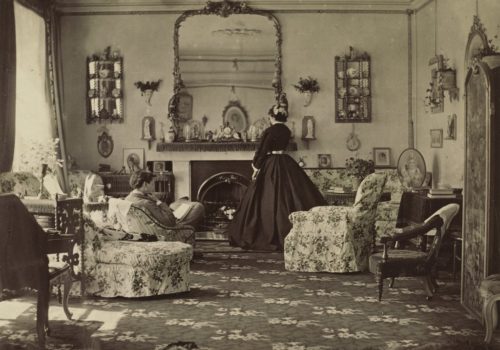Since October, Paris has been hosting a vast exhibition organized by the Musée d’Orsay and the Orangerie, with the Library of Congress in Washington, entitled Who’s afraid of women photographers? Divided into two segments, one covering the period 1839 to 1919, at the Musée de l’Orangerie, the other, at the Musée d’Orsay, devoted to the period 1918 to 1945, the exhibition aims at subverting the stereotype that photography is a male domain. So an institutional exhibition of this caliber was needed to show that women have played important and diverse roles as creators in the history of photography as well as in its technical evolution.
The two exhibitions emphasize women’s singular, dynamic relationship with photography through a series of works produced in different historical and sociocultural contexts, from the official invention of the medium in 1839 until 1945.
The exhibition starts at the very origins of the médium, through the works of Constance Talbot, wife of the English inventor of photography and first female practitioner of the new technique. Anna Atkins, the author of the first work illustrated with photographs (1843-1853), to Frances Benjamin Johnston and Christina Broom, pioneers in American and British photojournalism, no less than 75 photographers are brought together around images of major artists like Julia Margaret Cameron and Gertrude Käsebier. Whether these women worked in isolation or, already for some of them, in a collective effort, the aim will be to allow today’s audience to appreciate how a photographic tradition that has long born the seal of “female” norms revealed itself to be a possible path to emancipation and subversion for certain exceptional creators.
First and foremost, the exhibition attempts to show how photography, starting from the mid-19th century, contributed to raising women’s level of sociability by promoting their entrance into spaces for exchanges that made up the first professional networks and photography enthusiasts. Because the technical apprenticeship and the actual practice of the medium that followed were not regulated by any structure like those which, in the fields of painting or sculpture, considerably restricted women’s access, many of them felt encouraged to embrace the new “industrial art”. According to their social class, they mainly saw photography as a new business opportunity or as a way to satisfy a desire for personal creativity; these women all considered the practice as a chance to exist independently of domestic and family obligations and to think of themselves, and later assert themselves, as attentive observers.
By calling the permeation between classic theatre and photographic theatre into question, the exhibition goes on to highlight the photographers’ favourite themes for the exploration of “female” domains, particularly notable starting from the 1860s in the categories of portraiture and fiction. Here the exhibition examines in particular how the representation of female figures, those showing motherly feelings or the world of childhood, could have been fuelled both by this experience that was significant and specific to their female creators, and the photographic potentials of the intimacy with their models.
Mirroring this, challenges in the area of depiction arose naturally for women when they took on the topic of gender differences: considering the husband, the father or the great man, offering a vision of the couple, questioning gender identities or the depiction of the nude male and female body, etc. All were photographic efforts that more than ever involved positioning one’s self vis-à-vis a male perspective, whether it be that of the photographed model, that conveyed by centuries of iconography or that of contemporary spectators and critics.
Finally, the exhibition endeavours to reveal a new form of positioning, which pervaded at the turn of the century through the growing phenomenon of women’s intrusion and implication, as photographers, into the public sphere. Supported by the progressive ideology of the Anglo-Saxon New Woman, this change led to the complete abolition of borders between the male and female territories of the photographable : studio practitioners but also pioneers in documentary photography and photojournalism explored the street and the world, celebrated industrial construction and activity, took an active part in the question of social and ethnic minorities, education, work, women suffrage, in the representation of the events on the very front of the First World War.
EXHIBITIONS
Who is afraid of Women Photographers?
Oct. 14, 2015 – January 24, 2016
• First part: 1839-1919
Musée de l’Orangerie
Place de la Concorde, Jardin des Tuileries (côté Seine)
75001 Paris
France
Everyday except Tuesday 9am-6pm
http://www.musee-orangerie.fr
• Second part: 1918-1945
Musée d’Orsay
1 rue de la Légion d’Honneur
75007 Paris
France
Everyday except Monday 9am-6pm, Thursday until 9.45 pm
http://musee-orsay.fr
















